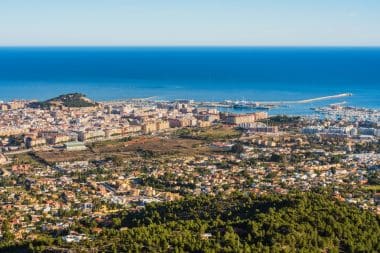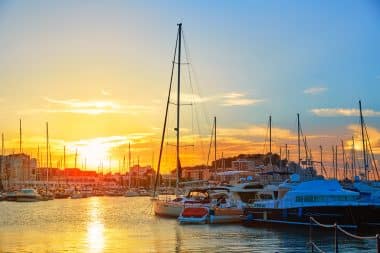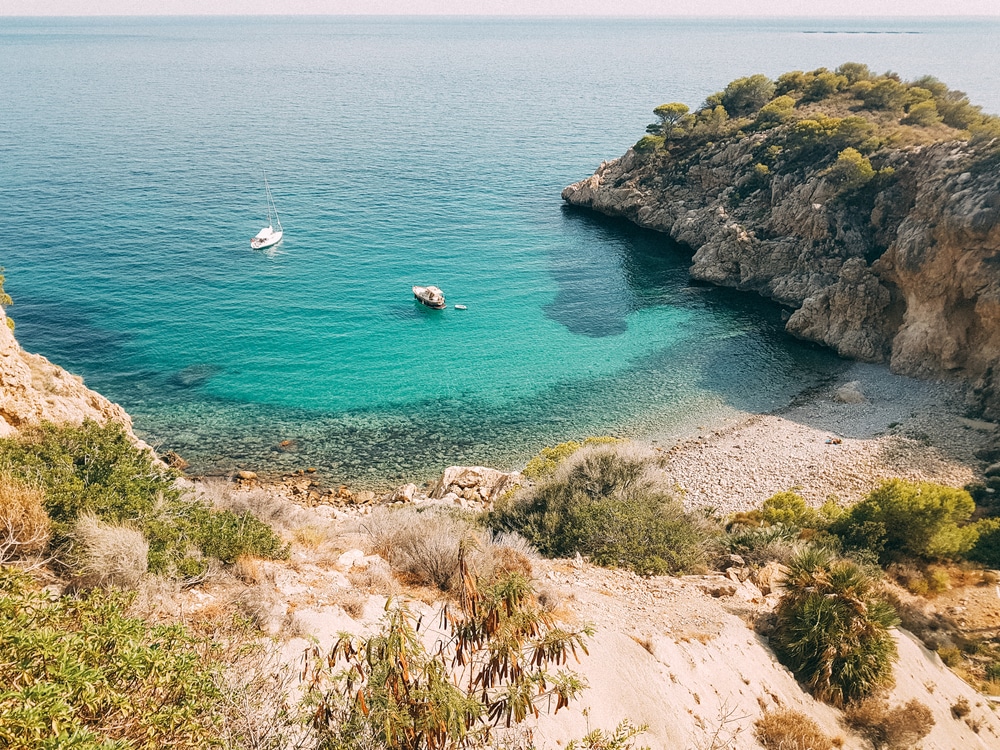The idyllically situated and sun-drenched Spanish city of Dénia is located on the northern Mediterranean coast of the province of Alicante. With an area of just over 66 km², Dénia is the second largest and, with currently over 46,000 inhabitants, the most populous city in the surrounding comarca of Marina Alta. In the neighbourhood are the towns of Oliva, Ondara and Jávea. The 753-metre-high Montgó mountain, sometimes called the “Sleeping Elephant” because of its characteristic shape, towers majestically above these equally touristy seaside and holiday resorts, which is recommended as an excursion and hiking destination for all fitness levels and ages. If you want to go to the cross or to the summit, you can be prepared for sporting activity.
A hike to Cabo de San Antonio with its lighthouse and view of Jávea over flatter high-altitude paths with Mediterranean vegetation is also very attractive, a return trip to Dénia by boat from Jávea is a good idea. There, Dénia’s three port areas are home not only to fishing boats, pleasure boats and yachts, but also ferries for regular connections to Mallorca and Ibiza.

Between the Montgó and the Segaria mountain range stretches the fertile plain known as Plana de Dénia, which has always been intensively used for agriculture and especially for the cultivation of oranges. Irrigation is provided by the Río Girona River, which flows into the sea at Almadraba, where it forms the small delta of La Punta. Off the coast in the direction of Jávea is the marine reserve of the same name, named after the headland Cape San Antonio, and also an excellent hiking area, where you can constantly let your eyes wander between mountain massif and rocky coasts. Here is also the destination of Cova Tallada, a cave at sea level, which was used for limestone extraction from the 16th century, but in the interior of which relics from the Muslim XI and XII centuries have also been found.
Although Dénia is clearly a tourist centre, it retains its Spanish character – in different parts of the city, such as the historic centre and the old and new port, you can experience a pleasant, rarely crowded tourist atmosphere, you never have the feeling of living in an artificial world created only for holidaymakers, the mix of locals, national and international residents and holidaymakers creates a pleasantly natural atmosphere. The numerous festivities and parades, which are always suspected by visitors of only serving as a folkloric tourist attraction, can also be traced back to a local tradition of the local population that is deeply felt as everywhere in Spain . Among the highlights here are certainly the fiestas “Fallas” in March and “Moros i Cristians” in August.
You will certainly feel at home in the hinterland of the Marina Alta: Mediterranean mountains with hiking trails, caves, river valleys, orchards, smaller mountain villages that invite you to take a break with a caña (a small draught beer) with a few tapas. An inexhaustible network of even smaller country roads in the mountains makes the area a paradise for cyclists and e-bikers. It is no coincidence that you can find numerous international professional teams training here in spring in preparation for the season.
The city grew very quickly in the 20th century and is still attractive as a place to live today
The favourable geographical conditions, each with relatively short distances to the two major cities of Alicante and Valencia, the warm and mild Mediterranean climate with up to 320 days of sunshine per year and the enviable location directly on the coast with over 20 kilometres of the finest sandy beaches made Dénia a popular bathing destination among Spanish visitors as early as the late 1950s.
In the mid-1960s, under the impression of increased growth and influx, there were plans, mainly characterized by land speculation, to build on the entire coastal strip with multi-storey buildings, but fortunately and not least for reasons of nature conservation, this was quickly discarded. Nevertheless, numerous holiday homes have been built in and around Dénia since then, as well as smaller and medium-sized hotels. In the summer peak season, the temporary number of inhabitants can quadruple to up to about 200,000. Between 1970 and 2021, the population almost tripled from 16,000 at the time to 46,000 today.
Not quite 30 percent of today’s population originally comes from abroad. A total of 111 nations are represented, you meet many Latin Americans and Central Europeans, but English and Germans form the strongest group with 1300-1400 inhabitants. Interestingly, however, the number of resident Germans has halved in the last 20 years.
As already mentioned, many former Denia holidaymakers decide to purchase a holiday home on site, which then often develops into their main place of residence. There are endless possibilities, from an apartment with sea views and communal pool, to a typical Spanish house with views on MontGo, to quieter settlement houses inland. You should get in touch with specialists who can help you reconcile your needs, wishes and wallet. More information: Asesor inmobiliario SAFTI Wolfgang MARINGER Dénia (03700) | SAFTI
Natural beauties as well as beaches with sand or stones are here in abundance for every taste
The biggest and most famous crowd puller of the city is undoubtedly its beach, which is divided into several sections and stretches over a coastline of about 20 kilometers and has state-recognized quality and environmental certificates. North of the center of Dénia and in the so-called “Zona Marinas” there are a total of 17 quite wide, fine, clean and well-kept sandy beaches. The Albaranes, L’Almadraba, Les Bovetes, Les Deveses, Els Molins, Les Marines and Punta del Raset sections are the most visited beaches. On the positive side, the kilometre-long extension of the beaches ensures a good distribution of visitors even in summer and makes overcrowded beaches practically impossible.
To the south, the so-called “Zona Las Rotas” is dominated by the smaller, mostly rocky, but very picturesque bays of Les Arenetes, Marineta Cassiana, El Trampolí, La Cala and La Punta Negra, which are connected by a modern waterfront promenade (“paseo marítimo”). These latter sections and bays have an excellent reputation among water sports enthusiasts as snorkeling and diving spots. Sailors and kitesurfers also get their money’s worth in Dénia. There are also several high-class equestrian centres and golf courses in the vicinity.
Not far away and easy to reach by rental car in just a few minutes drive from Dénia are also the equally charming beaches of Playa del Arenal, Playa de la Barraca and Cala de la Granadella in or near Jávea. A little further south in the direction of Moraira, there are other attractive bays, e.g. Cala de Moraig and Cala de Llebeig.
In and around Dénia, people have enjoyed living since over 2,000 years ago

From a cultural point of view, the port city of “Dianium”, which was already wealthy in antiquity and named after the Roman goddess Diana and already known nationwide, offers numerous attractions and sights. Wine production began 2700 years ago, which developed into a major economic factor 700 years later and helped Dianium to flourish under the Roman emperors Claudius and Nero. The Campiña de Dianium was home to 68 wineries and 17 amphorae production centres. Of the 10 amphorae produced, 9 went to the wine trade, one to olive oil. The wine was exported by ship, mainly to Gaul, Liguria, Rome and Sicily. Even today, Spanish wines do not need to hide internationally, to which many wineries in the area around Valencia and Alicante also contribute.
Located directly at the port of Dénia and right in the center, the landmark of the 11. to 12th century fortress “Castillo de Dénia” built by the Islamic rulers of the city. The imposing structure can be seen from afar from both land and sea and houses other architectural treasures such as the two defensive towers from the 15. and the former governor’s palace from the 16. and 17th century.
The archaeological museum is also located here, where finds from excavations from the surrounding area can be visited. For guests interested in history, the fortified Benitzaina estate from the 18th century, the picturesque hermitage “Caseta del Pare Pere” of a monk from the 17th century on the slopes of the Montgó and the mighty watchtower Torre del Gerro near Las Rotas with the nickname “Jarrón” (vase) from the 16th century are also excursion destinations.
There is perhaps no better place to eat in the Spanish Mediterranean
Dénia’s location by the sea and the wide variety of fresh fruits and vegetables from the neighboring plain have made the city the preferred destination for gourmets and gourmets from all over the world from early on. Delicious local and regional specialties are primarily red prawns (with chard), the delicious seafood casserole “Suquet de Peix”, the grilled vegetables “Espencat” and the fish soup “Llandeta”. As an outstanding example of Mediterranean cuisine, even scientifically recognized as proven healthy, Dénia was included in the circle of “cities of gastronomy” by UNESCO a few years ago.
In the historic district around Carrer Loreto and the Old Town Harbour, holidaymakers will find a wide range of exquisite and first-class restaurants as well as cosy tapas bars all year round. A few years ago, the former warehouses were also converted into the authentic culinary and cultural site of Els Magazinos. Arroces, i.e. rice dishes, can be found everywhere, which is due to the fact that there are rice-growing areas in the Valencian Albufera but also in the nearby Marjal of Pego. Based on this, there is everything – from the world-famous “Paella Valenciana”, which, contrary to popular belief, delights the taste buds without seafood but with chicken and rabbit, to classic Alicantine variants with seafood, to the Arroz Negro, black by the ink of the squid, and lots of delicious alternative versions. At first glance, very similar to paella, the fideua is also tempting, which is prepared on a pasta basis. Tapas, fresh fish and grilled lamb chops remain popular classics.
In summary, it can be emphasized that Denia, with its Spanish soul, offers the visitor a naturally attractive backdrop in which nothing is left to be desired: whether you prefer the more traditional historic districts, the modern marina with bars and restaurants, the more rocky coast or miles of sandy beaches, or perhaps prefer nature in the hinterland, everyone will get their money’s worth in Denia.


